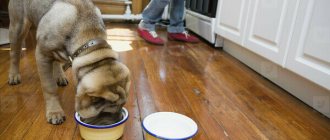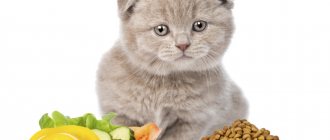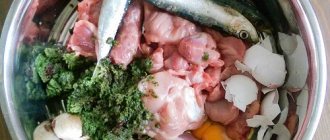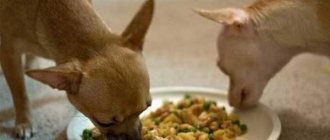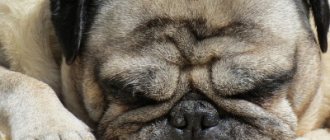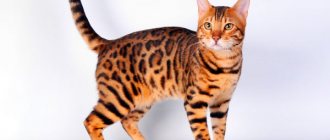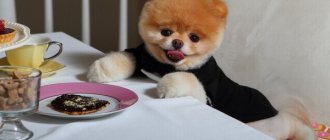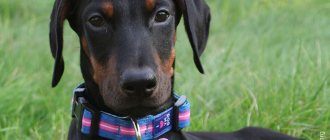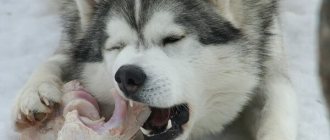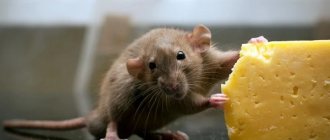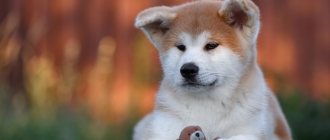What a pet eats determines its appearance, physical development, activity, health, and, ultimately, life expectancy. It is necessary to choose the most suitable diet for an Akita pet and at the same time take into account the breed characteristics of these dogs.
Natural food and artificial feed
Dogs of this breed may not tolerate chicken meat, as well as beef and pork, or even refuse to eat them. The reason is that over the centuries of their existence, Akitas have become accustomed to eating mainly fish and seafood, including algae. Their body digests light protein foods better than red meat. Feeding your Akita natural food can be expensive and quite time-consuming.
Most breeders prefer feeding their pets with high-quality industrial food.
If the dog eats “natural” food, then it is better if the basis of its diet is sea fish and seafood.
Is it so important?
Neighbor Bobik has been eating pearl barley and blue whiting all his life and is alive and well at 15. Maruska ate long bones, lived for 12 years and did not choke. Wonderful! But there are other stories. Tuzik ate anything and died at the age of 5 from old age. Linda chewed on a sharp bone, and it pierced the wall of her stomach.
When making recommendations, nutritionists and veterinarians focus not on the individual, but on statistics. And according to statistics, cheap granulated food causes kidney stones in animals, dumplings provoke pancreatitis, and sweets are a sure way to a set of problems with almost all body systems.
Your dog may be lucky with a tinned stomach. But do you want to test it on her?
It is not necessary to be fanatical about implementing all recommendations; adherence to general principles is sufficient. The ideal diet is compiled to prevent serious mistakes in the feeding system, and not to impose barracks life on us. After all, even athletes and nutritionists sometimes allow themselves a bottle of beer or a hamburger.
Positive and negative qualities of a “straight girl”
Natural nutrition has both advantages and disadvantages. Before making a choice in its favor, you need to carefully calculate how appropriate it is for you to feed your dog home-cooked food.
pros
- The owner chooses the products himself and can control their quality.
- Home-cooked food does not contain stabilizers, dyes or other harmful food additives.
- The owner of an Akita can change the pet’s diet based on the dog’s personal preferences, the state of its health and its capabilities.
- When feeding homemade food, the dog receives natural nutrients and trace elements.
Minuses
- The owner of an Akita must prepare a diet for his pet, taking into account its balance.
- Preparing homemade food takes a lot of time.
- A balanced natural diet will be more expensive than feeding high-quality ready-made food.
- Natural products can cause allergies in your pet.
- When feeding your Akita with homemade food, you will have to add vitamin and mineral supplements to the food.
Why is this so?
The digestive tract of the Akita and other dogs is identical. Indeed, historically, animals from different countries and climate zones eat slightly differently, but:
- the diet of the common ancestors of all dogs was approximately the same (game, the contents of its stomach, some plants);
- food is, first of all, not dishes, but a set of biologically active substances (BAS), and the menu should be compiled based on the ratio of nutrients in it;
- transferring human cultural code to animals, even domestic ones, is a mistake.
Let's take a closer look at the last point. It concerns not only the composition, but also the diversity of the diet, leading to additional feeding from the table, because the animal supposedly “gets tired of eating the same thing.” Humanization of pets leads to unhelpful and often downright dangerous enterprises: mating of non-breeding bitches for the sake of “the joy of motherhood” (that’s why we have so many homeless packs), refusal of castration for indications so that “the dog remains a man.” These are all harmful myths that need to be debunked whenever possible.
List of permitted and prohibited products
An adult dog can be fed the following foods:
- Boneless fish (sea and pre-frozen), seafood, as well as seaweed.
- Meat products: lamb, veal, horse meat, turkey or rabbit meat, as well as offal (preferably liver or heart scalded with boiling water).
- Porridge: rice, buckwheat or millet.
- Raw or boiled vegetables: carrots, pumpkin, zucchini.
- Fruits: apple, pear, banana, melon, if you are not allergic, then you can also have berries.
- Dairy products: cottage cheese, natural yogurt, kefir or yogurt.
Tendency to diseases, vaccinations
Like other large breeds, the American Akita often suffers from joint-related diseases. This is dysplasia of the hip and elbow joints. American women may suffer from diseases of the eyes, heart, and thyroid gland, which are inherited. Responsible breeders exclude such dogs from breeding. Overall, this is a healthy breed with good immunity.
Vaccinations, anti-worming treatments
Only absolutely healthy dogs can be vaccinated. 10 days before vaccination, puppies are given an anthelmintic. Dosage - according to the instructions, strictly according to the weight of the pet. Subsequent dewormings are carried out monthly until 6 months of age, then every 4 months.
Approximate puppy vaccination schedule:
- 8 – 9 weeks – complex vaccination against plague, adenovirus, parainfluenza, parvovirus + against leptospirosis,
- 12 weeks – revaccination + rabies vaccination,
- 1 year and then annually - repeated revaccination + rabies vaccination.
Industrial
Feeding with industrial feed (dry and wet) also has both advantages and disadvantages.
Advantages
- There is no need to waste time preparing food for your dog.
- There is no need to add vitamin and mineral supplements to your pet's food.
- There is no risk of parasite infection.
- Ready-made food will cost less than natural food.
Minuses
- Ready-made food may contain harmful chemical additives.
- If for some reason you can’t get your pet’s usual brand of food, problems may arise when trying to feed him another food.
Which food do you prefer: dry or wet? Wet is softer in structure, does not cause thirst in the animal, and moreover, it contains less “chemicals”. However, dry food is more convenient to take with you on the road, and it does not stain dishes or the dog’s fur. When choosing food for a dog of this breed, you can use the following rating, based on reviews of Akita owners and breeders:
- Purina Pro Plan.
- Acana.
- Artemis.
- Belcando.
- Canidae
- BioMill.
- Almo Nature.
- Royal Canin.
This rating includes food of at least premium class, since budget-class diets are not suitable for Akita.
The most suitable food for Akitas is rice-based food with the addition of salmon or tuna.
Dry food - which is best for Akita Inu (premium), rating
Only premium and super premium mixtures are suitable for feeding Akita; you can find them in specialized stores.
The ideal option would be holistic nutrition for dogs with food intolerances and allergies..
Holistic-class mixtures are now difficult to find on the Russian market; Purina Pro Plan “Salmon with Rice” food would be a good replacement.
To select food for your pet, you can use the following ratings::
- Purina Pro Plan;
- Akana;
- Holistic Artemis;
- Belcando;
- Canide;
- BioMill;
- AlmoNature;
- Royal Canin.
The list contains foods with good ratings that are theoretically suitable for Akita Inu. Before choosing food, be sure to consult with a specialist.
Feeding the puppy
In the first days after purchasing puppies, it is recommended to feed them what they are used to eating in the breeder’s home. Later, you can gradually transfer the baby to another diet that is more convenient for the owner.
Up to two months
Puppies are fed six times a day. The daily diet necessarily includes meat or fish, which are fed to the pet at 100 or 200 grams per day, cottage cheese (up to 150 grams per day), as well as milk, kefir or low-fat yogurt, vegetables and cereals - all 100 grams per day.
At two
The number of feedings is 5-6 times a day, while the rate of feeding meat or fish increases to 200-300 grams, cottage cheese, as well as milk or fermented milk products - up to 200 grams. The share of vegetables in the diet can also be increased slightly, to approximately 150 grams.
Three
The puppy is fed 4-5 times a day. His diet must include 300-350 grams of meat or fish, as well as up to 200 grams of cottage cheese, dairy products and vegetables. The proportion of porridge also increases and now amounts to 150 grams.
Four and five
By this age they switch to three or four meals a day. The amount of fish or meat products reaches 400 grams, cottage cheese and vegetables - 250, and porridge up to 200 grams.
By the age of four months, milk should be eliminated from the diet and replaced with kefir or natural yogurt.
After six months
The puppy is transferred to three meals a day. At this time, the amount of meat or fish in his diet increases to 500 grams, cottage cheese to 300, vegetables to 250, and porridge to 200 grams.
How to properly feed an American Akita
The American Akita's food should be rich in the right fats, minerals, and vitamins. The main necessary types of food are protein, meat, complex carbohydrates. The diet must include fiber, calcium-containing foods, and sodium. Nutrition should not only satisfy the needs for microelements, but also support the dog’s body during changes in season, age, and condition (for example, during pregnancy).
Foods that should not be offered to your dog:
• any sweets. Glucose needs can be met with fruits and a small amount of honey;
• smoked meats and hot sauces. Consumption of these products leads to the development of gastritis and enteritis in dogs;
• fatty foods. These products are extremely dangerous for dogs' livers. Their use can lead to the death of the animal;
• any bones, especially chicken and rabbit. Sharp bone fragments can cause perforation of the stomach and intestines. Boiled bones simply clog the digestive tract and cause inflammation. For the same reason, you should not feed ground bones to your dog;
• bakery products. These foods cause strong fermentation in the dog’s digestive system and can lead to gastric volvulus;
• potatoes and beans. They do not cause harm, but are not absorbed by the dog. As a last resort, if the dog is interested, you can offer him a piece of raw potato;
• any herbs, spices and aromatics. They are found in cookies, baked goods and other human foods and can cause allergies in dogs;
• pearl barley and barley cereals. Such cereals are not digested in the dog’s body and do not benefit it.
Features of organizing dog nutrition at home
In the feeding process, an important point is not only what to feed the dog, but also how to do it. There are general rules for organizing feeding for dogs of all breeds and ages:
— Feeding is carried out after a walk to avoid such an unpleasant phenomenon as volvulus.
— After feeding, the dog should be at rest for at least 1-2 hours.
— Equip your pet with a “dining room.” This place should be clean, away from household chemicals and other dangerous things. Maintain hygiene of dishes and water.
- You cannot give a dog food from the owner’s table, no matter how much the dog asks for it. A harmless piece of bread or sausage can introduce an animal to diseases such as pancreatitis, enteritis, and gastroenteritis.
— The main criterion in determining the serving size is the weight of the animal. The daily portion should be 4-7% of the dog’s weight and divided into two doses. If you miss one of the daily feedings, you cannot increase the portion and give the entire amount of food at one time. The dog will overeat and will develop indigestion.
- You need to feed your dog at the same hours. If there is food left in the bowl after feeding, do not leave it until the next meal. The bowl with the remaining food should be removed after 20-25 minutes. Food constantly remaining in the bowl indicates that the portions are too large. In this case, the amount of food should be reduced. But it also happens that the dog eats everything, and then sniffs around the house for something edible, or begins to beg for food from the table. This means that the dog is not getting enough to eat and the portion size needs to be increased.
— Dogs eat quickly, and they don’t feel full right away, but after some time. You should not feed your pet until he refuses to eat, this leads to overeating. In any case, the portion should be standardized.
Feeding errors
— They strive to constantly include something new in the dog’s diet. A dog does not need variety; it must consume a strictly balanced composition of foods so that the body works correctly, without failures.
— The dog is fed exclusively meat products. Lack of fiber in food leads to a decrease in the animal's immunity and permanent digestive upset.
— They forget to provide the dog with clean water, believing that it is enough for her to drink once or twice a day. Lack of fluid leads to dehydration of the animal's body.
— You cannot mix dairy and meat products in one meal. It is better to give meat in the evening, and dairy products in the morning.
- Make sure your pet's food is at room temperature: neither cold nor hot.
Deciding on the type of food
Ready-made feed
Ready-made food is divided into various groups according to energy value, content of vitamins and minerals, taking into account the needs of the dog from birth to the end of life. There are milk replacers for weaned babies, food for puppies, teenagers, adults and aging dogs, for animals exposed to high physical and emotional stress (hunting, service, various competitions), and for those pets who do not lead a very active lifestyle . Be sure to buy tendon bones for your pet to strengthen and clean their teeth. They perfectly replace natural bones, but are completely safe.
When eating dry food:
• don’t go after cheap prices, choose high-quality branded food. They require less than a cheaper product and are balanced, which means you don't need to buy any vitamins or mineral supplements. Consult your breeder or veterinarian. Let the experts help you choose ready-made food for your pet;
• strictly follow the manufacturer's recommendations indicated on the packaging, taking into account the age, load and health status of the dog;
• pay attention to the dosage! Don't overfeed your pet
• Make sure your dog has fresh drinking water. This is important for any selection of nutrition, but especially if you use ready-made balanced food.
Natural feeding: what to include in the menu
Raw meat.
Allowed varieties: Beef, turkey, chicken, horse meat, rabbit, game (venison, elk, wild boar, etc.)
Acceptable method of preparation: Boil. Give it raw only if you are sure there are no parasites. For delicacies - dry them with a moderate amount of salt. You can also give thin pieces of frozen meat as a reward. Wild meat is only thermally processed. Meat should not be given in the form of minced meat, because the product does not have time to be digested. From two months old, the puppy can be given meat with veins and small cartilages. Pork and other fatty meats and animal fats in general are a threat to the liver of any dog!
The meat must be fresh! To protect your pet from worms, it is advisable to freeze meat products in the refrigerator, first dividing them, and then defrost them in portions, carefully inspect them for helminths, chop them finely and pour boiling water over them. When the dish has cooled, it is ready to eat.
You can give your pet poultry, game and rabbit meat, but only in boiled form. You should not feed your dog raw hunting trophies or bones (only bird necks are considered safe).
The puppy needs cartilage. They contain essential minerals and are very popular with your pet. For an adult dog, it is useful to buy tendon bones, pig ears and similar products at the pet store. It is not dangerous to the health of the animal, contains many elements necessary for the body, strengthens teeth and simply entertains your friend, especially when you are busy and cannot give him much attention.
Offal. These include beef liver, kidneys, lungs, trachea, lips, tripe. These products are less nutritious than meat, but are also very healthy. They must be thoroughly washed and boiled.
I would especially like to dwell on the tripe (beef stomach). It has a sharp and unpleasant smell, but for dogs it is an excellent, tasty food, rich in beneficial microelements and enzymes. The tripe must be thoroughly washed and boiled a little. Feeding rumen helps discourage your dog from eating feces.
Fish. Sea fish can be given to your dog 2-3 times a week instead of meat. It is better not to feed your four-legged friend river fish, as it is often infected with helminths.
The fish should be boiled. It’s good when it’s small, with soft bones that are not dangerous to your pet’s stomach. Otherwise, the bones must be selected carefully.
It is impossible to overuse feeding of fish products, since they do not replace meat, and in large quantities they can lead to disruption of the vitamin and mineral balance in the animal’s body, and this contributes to a decrease in immunity and the occurrence of kidney disease.
Eggs. Avoid giving your adult dog raw egg whites frequently. For a puppy, it is simply unsuitable for food - it causes vitamin deficiency, destroying certain vitamins in the body of a young animal. It is better to boil the eggs whole and give them to your pet no more than once or twice a week.
Dairy products. Unsweetened fermented milk products are recommended for dogs of all breeds and ages. Kefir, cheese and cottage cheese are especially well absorbed. As for milk, it is good for puppies no older than six months.
A dog should receive cottage cheese from childhood. Until 3–4 months, the baby should be offered cottage cheese made at home. To do this, mix a liter of pasteurized milk and a liter of kefir, let the mixture sour for several hours, then heat it, drain it on cheesecloth and strain off the whey. You can make calcined cottage cheese - add 10% calcium chloride (buy at a pharmacy) to boiling milk at the rate of 2-3 tablespoons per liter of milk. An older puppy (from two months old) can also be given store-bought cottage cheese.
Cereals. Cereals are given to the dog only in boiled form (steaming them is not enough). You can offer your animal rolled oats, but only infrequently, otherwise your pet will develop diarrhea and the anal glands will become inflamed. You can also use buckwheat and flaxseed to feed a puppy and an adult dog. If the puppy is younger than two months, it is better to grind buckwheat and rolled oats in a coffee grinder.
Vegetables. They supply the dog’s body with vitamins, minerals and fiber. The puppy should be accustomed to vegetables gradually, giving them raw, grated and seasoned with sunflower or linseed oil. Low-fat sour cream will also work. This dressing promotes the absorption of vitamins. Such salads are given along with meat, dairy products and porridge to both young and adult dogs.
Vegetables are strong stimulants of gastric juice secretion. Their consumption promotes more complete digestion and absorption of proteins, fats, and carbohydrates contained in other foods. The most suitable foods for feeding dogs are pumpkin and zucchini, carrots and beets. It is advisable to give them every day.
It is useful to periodically include ripe crushed tomatoes in your animal’s diet, as they strengthen the cardiovascular system.
Vegetables also mean good vision, high immunity, and a healthy digestive system. When giving your pet garden fruits, you should remember that almost all of them cause a slight laxative effect.
After eating beets, dogs' urine and feces turn red or burgundy for a short time. This should not cause panic in the owner.
Fruits and berries. They can be added to your dog’s main food, or you can pamper your four-legged friend between meals. Apples are especially good for a dog’s body. They contain potassium, copper, iron, vitamins, and organic acids. These fruits are very useful for puppies, pregnant and lactating bitches, old dogs, as well as animals recovering from illnesses. Grated sour apples must be included in the diet for diarrhea, as they cleanse the intestines of toxins and other harmful substances and have a detrimental effect on pathogenic microflora. Pears, strawberries, raspberries and other fruits and berries are also useful.
Greenery. Greens used include lettuce, spinach, and parsley. They need to be finely chopped and added little by little to the dog’s food. These three types of plants are extremely beneficial for young, mature and aging pets.
You can also use wild herbs - nettle and dandelion. Do not forget that they need to be collected away from roads and industrial enterprises.
Nettle is consumed both fresh and dry. Fresh grass must be poured with boiling water so that it loses its stinging properties. Then it is crushed with a knife or through a meat grinder and added to the dog’s food. You can also use the water left over from soaking if it is clean. Dry nettle is brought to a powder state before use.
Young dandelion leaves are soaked in warm salted water for 30–40 minutes, then finely chopped, poured with a small amount of sunflower oil and added to food.
Plant food must be added to the dog’s meat, otherwise he may refuse such a treat.
Food for an adult dog
An adult Akita is fed twice a day - in the morning and in the evening. During the day, you can give your pet additional treats during training sessions, but in this case you will need to slightly reduce the portion during the next feeding. The total daily food intake with natural feeding is approximately 2-3% of the total weight of the animal. In total, the Akita’s diet should include the following foods:
- Meat, fish or offal - from 500 to 600 grams.
- Porridge (rice, buckwheat or millet) - from 200 to 250 grams.
- Vegetables (raw or boiled) - chopped, approximately 250 grams.
- Kefir, curdled milk or natural yogurt - approximately 150 ml.
- Cottage cheese - 200 grams.
- Boiled egg - 1 yolk once a week.
If the animal eats ready-made food, it should be selected in accordance with the dog’s health and physical activity.
For animals suffering from allergies or other diseases that require special diets, special dietary foods are suitable.
Peppermint treat
What to feed a Jack Russell Terrier: rules, diet, useful tips
Ingredients:
- 1 medium overripe banana.
- 2 chicken eggs.
- 3 tbsp. spoons of honey.
- 3 tbsp. tablespoons of liquid coconut oil (can be replaced with sunflower oil in the same amount).
- 1/2 teaspoon mint flavoring.
- 1/2 teaspoon baking powder.
- A quarter cup of carob (roasted carob powder). A small amount of cocoa can be substituted, but this is not recommended for animals. Therefore, try to find an original product.
- Oat flour.
Cooking procedure.
1. Mash the banana in a bowl.
2. Beat eggs into the resulting mass, add honey, baking powder, cinnamon and coconut (sunflower) oil.
3. Add oatmeal to the mixture to form a firm but slightly moist dough.
4. Divide the resulting volume into 2 equal parts.
5. Pour 1/4 cup of carob powder into one half, and add the same amount of flour to the second half. A hard lump should form that does not stick to your hands.
6. Roll out 2 rectangles, 9-10 mm thick.
7. Place the layers of dough on top of each other and roll along the long side. Wrap the resulting sausage in plastic wrap and put it in the refrigerator overnight.
8. Preheat the oven to 180 degrees.
9. Cover a baking sheet with parchment paper.
10. Remove the film and cut into 3-3.5 cm rounds.
11. Place on a baking sheet. During cooking, portions of dough will not increase in volume, so you can place them close to each other.
12. Bake for 10-15 minutes.
If you want to please your pet with a crunchier treat, cut the rolls into thin slices (about 1 cm), and after cooking, additionally dry them in a warm oven or even in a non-stick frying pan.
The finished product is stored for a long time in a dry place. So, by baking peppermint rolls once, you can treat your four-legged pupil with them for a long time.
Bon appetit to your dog!
I like it I don't like it
Mixed diet
Most dogs of other breeds do not tolerate a mixed diet well, but an Akita can alternate between home-cooked food and commercially prepared food. This food option for representatives of this breed is considered quite acceptable if it suits the owner of the dog and the dog itself. However, it should be remembered that mixed nutrition does not mean feeding natural products and ready-made food at one time, as this is fraught with serious problems with the pet’s health.
Description of the breed
Akita is one of the oldest breeds in the world, the first mention of which dates back to the second millennium BC.
It got its name from the Japanese “inu”, dog, and the name of the province on the island of Honshu, from where it began to spread throughout the country and the world. Founded in the 20s of the 20th century, the Society for the Protection of Akita Inu takes care of preserving the purity of the breed, not allowing any crossing of Akitas with foreigners. These individuals also performed well during the Second World War.
Appearance
You need to know that the Japanese standard (AKIHO) and the requirements of the International Canine Organization (FCI) have slight differences, so when purchasing a puppy, you must read the receiver's license to find out which standard it adheres to.
Boys' height is 64-70 cm and weight 40-45 kg. Indicators for girls: 58-64 cm and 32-45 kg, respectively. The AKIHO standard allows for larger pet sizes.
The Akita is characterized by a large head with a wide forehead without wrinkles. The eyes are deep-set and slanted, dark in color. The nose is black, the lips are pressed tightly. Triangular ears, with a rounded tip, are parallel to the neck. The Japanese believe that the shape of the ears emphasizes the high level of intelligence of the animal.
The body is moderately elongated, with a higher elongation coefficient in girls. The neck is straight, the limbs are muscular and strong. The tail is in the form of a ring, quite long and thrown over the back.
Hard and elastic wool can have the following types of colors:
- white,
- black,
- spotted,
- ginger,
- brindle.
Moreover, these types of colors are regulated by the FCI; the Japanese, in the latest edition of the AKIHO standard, excluded dark and spotted colors as acceptable
It is also important to know that puppies that are exclusively white are often susceptible to deafness.
With proper upbringing and care, a dog's life expectancy is from 10 to 15 years.
During pregnancy and after childbirth
During the first month of pregnancy, you cannot dramatically change your pet’s diet or, especially, increase the portion size. Some bitches may be predisposed to toxicosis, which is why they often refuse food. There is no need to force your pet to eat when she has no appetite. But you can offer her her favorite food, which she usually does not refuse.
Starting from the second month of pregnancy, it is necessary to gradually increase the amount of protein foods in the bitch’s diet. If the Akita was fed a branded food before pregnancy, it is recommended to switch it to a ready-made diet intended for pregnant dogs or the smallest puppies. The number of feedings also increases: if in the first month of pregnancy the dog is fed 2 times a day, then from about the fifth or sixth week of pregnancy the number of feedings increases to three, and closer to childbirth - up to four times.
A week before the expected birth, meat is completely excluded from the bitch’s diet and replaced with boiled sea fish without bones. After whelping, the dog should be offered some light protein food to restore strength. Grated boiled meat or fish, as well as cottage cheese mixed with kefir or natural yogurt, work well.
At this time, the number of feedings is 5-6, and food is fed in small portions. In the second or third week after birth, the amount of food is doubled, and the dog is fed 4 times a day, and by 4-6 weeks the number of feedings is reduced to three.
When feeding natural food, the bitch should receive vitamin and mineral supplements from the very beginning of pregnancy.
General recommendations for healthy eating
To organize healthy feeding of your pet, try to adhere to the following rules:
- Offer your pet light protein foods, if possible more fish and seafood;
- carefully monitor allergic reactions, eliminate possible allergens from the diet;
- watch the portion size, do not overfeed;
- stick to a specific feeding schedule at the same time;
- in the summer, give low-fat food; in winter, the diet may be slightly increased;
- give preference to fermented milk products: kefir, yoghurt;
- organize the main feeding of the dog in the morning;
- Give your pet raw meat, finely chopped, and boiled fish;
- after eating, give your pet rest for 1-2 hours;
- do not forget to ensure that the bowl of water is always full;
- Do not give your pet food from your table.
Before serving raw meat to the dog, it must be doused with boiling water to eliminate the presence of parasites . It is also advisable to store portions of meat products in the freezer.
Features of food for an old dog
In old age, the animal's activity decreases, which is why the pet can quickly gain excess weight. Therefore, you need to reduce your caloric intake. The best option would be to switch your pet to special food for older dogs. If an elderly Akita has any health problems, then a special dietary food will be suitable for her.
Before making any changes to your aging pet's diet, you should consult your veterinarian. He will help you choose the most appropriate feeding option.
Pedigree for healthy skin and coat, beef, 13 kg (for large breeds)
PEDIGREE helps reduce the risk of tartar and plaque formation on your pet’s teeth. Provides him with normal digestion. It is preferable to feed your pet dry food in a container separate from wet food, and ensure the availability of fresh drinking water. This is quite healthy, tasty dog food. It is produced taking into account the physiological needs of a large four-legged pet. The food is produced by a Russian company and is designed for the economy category.
- Convenient packaging.
- Pleasant aromatic and taste properties.
- The pet eats with pleasure.
- No artificial flavors.
- High quality crackers.
- Comfortable in using.
- Lots of vitamins.
- The coat takes on a healthy, beautiful appearance.
- Negative reputation.
- Missing useful components.
- Worse than normal nutrition.
- Doesn't do any good.
- Harmful to the health of the animal.
- The pet quickly gets used to this food and does not eat anything else.
- Increases salivation.
